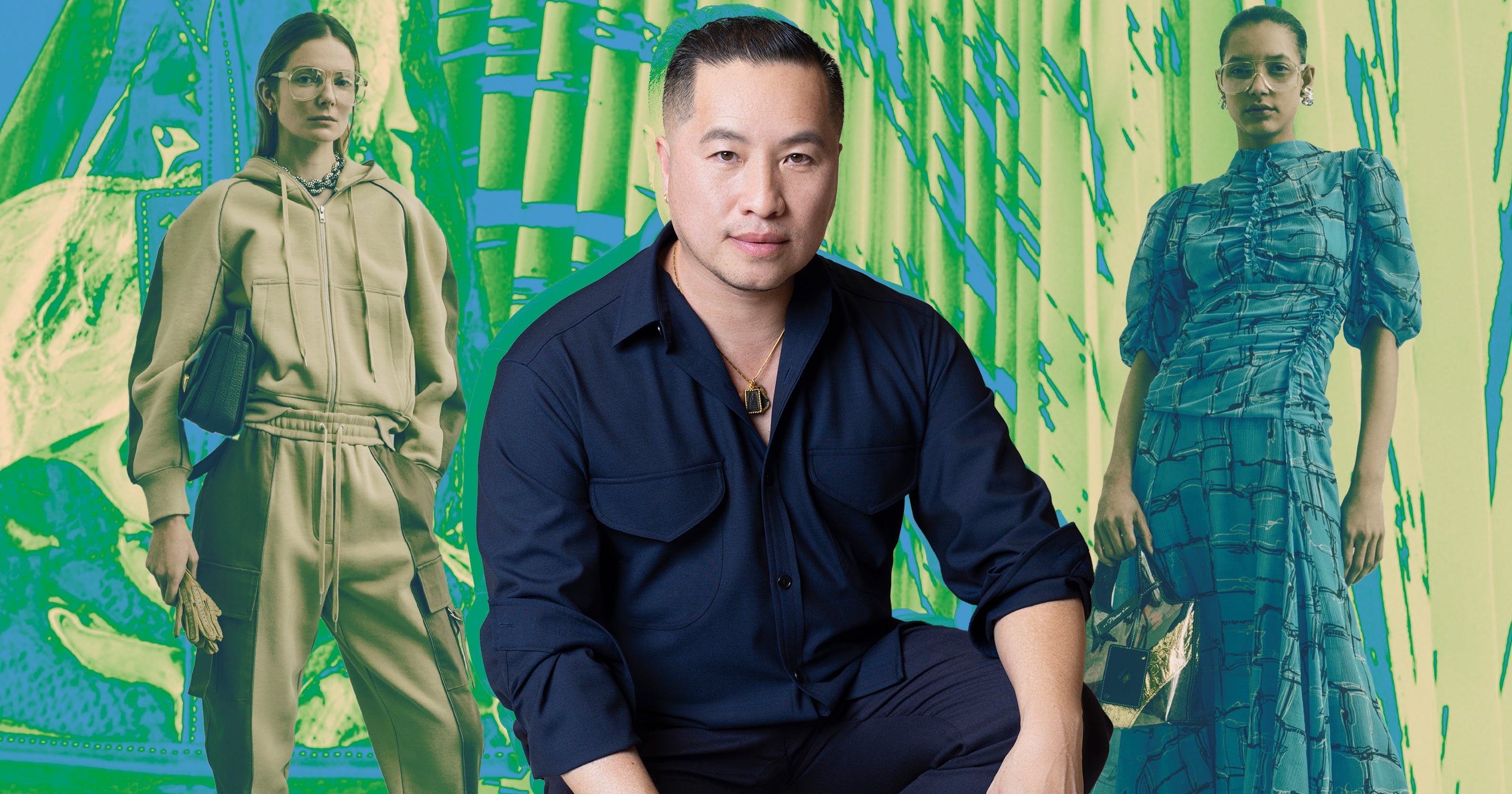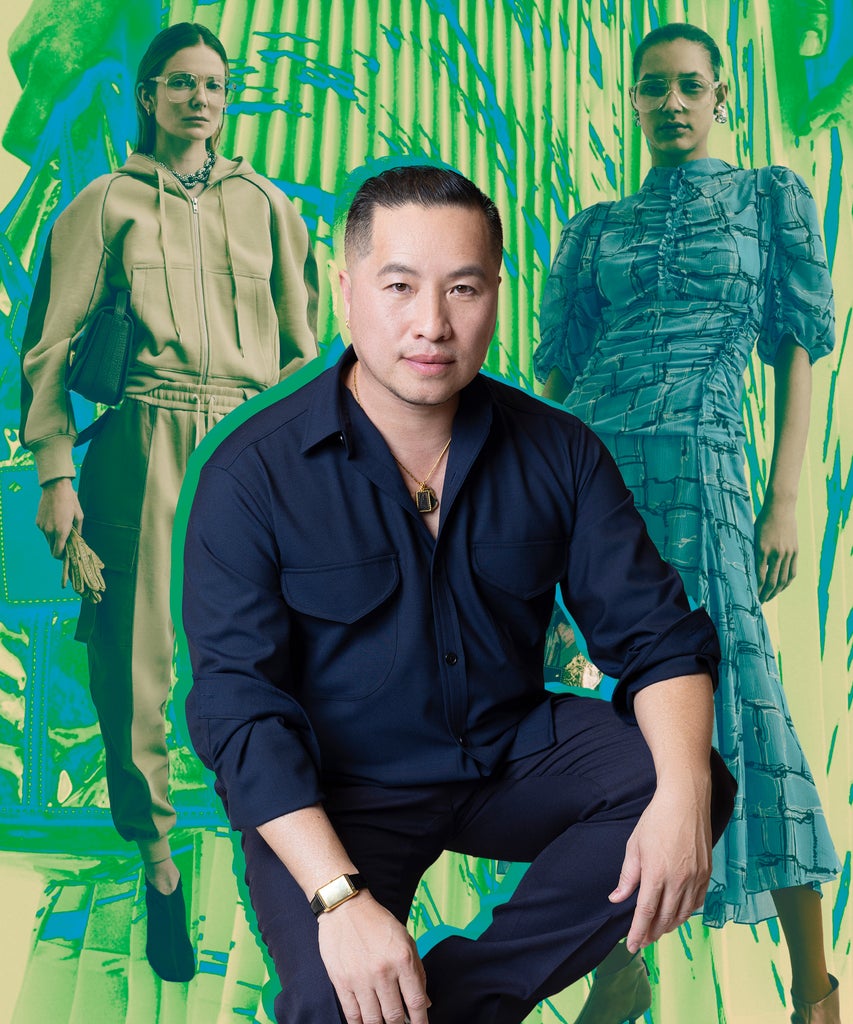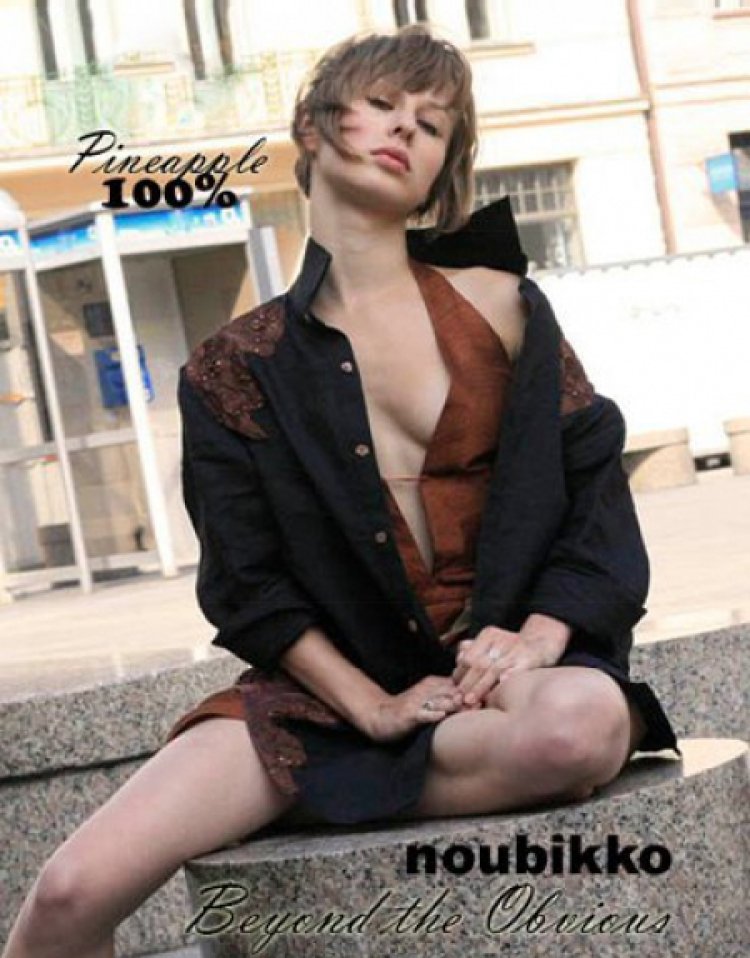20 Years In, Phillip Lim Is Making Fashion For Today’s “Reality”
.disclaimer{width:90%;margin-bottom:1rem}.disclaimer__lines{width:100%;margin:0 auto;border-bottom:1px solid #999;padding:0;max-width:150px}.disclaimer__copy{width:100%;max-width:355px;font-family:Brown Regular,sans-serif;font-size:.9rem;font-weight:300;line-height:1.3em;color:#333;padding:0 0 .4rem;margin:1rem auto;text-align:center} All linked products are independently selected by our editors. If you purchase any of these products, we may earn a commission. There are a handful of words that come up a lot when talking about 3.1 Phillip Lim: cool, easy, modern, Pashli. Save for the last one — the name of the brand’s most popular bag from the 2010s — these could feel like vague, throwaway descriptors that apply to a host of fashion brands coming out of downtown Manhattan. But they encapsulate the distinct ethos of what designer Phillip Lim and co-founder Wen Zhou have been building for the past 20 years, a milestone marked on the 3.1 Phillip Lim spring/summer 2025 show on the runway at New York Fashion Week on Sunday. Despite now being inextricably linked to New York City, back in 2005 when the brand was starting out, Lim and Zhou were part of the latest wave of transplants out of L.A., where the two fashion creatives met while working in the industry (he as a designer at a brand, her at a company that sold fabrics), with a desire to start something new. “There was no groundwork. It was purely from a place of need, want, and why not,” Lim says. “We were young professionals coming up, working for a living and paying bills, but we also wanted to have nice things and dream up designs that we could afford and that our friends could afford.” While they both had industry experience, which helped, they didn’t have the textbook bona fides of fashion school degrees and stacked resumes of their fashion contemporaries. “It was so shoot-by-the-hips and guttural,” Lim says. What they did possess, though, was a deep, personal understanding of who they were serving. “We were and are our audience. We were and are the consumer,” he says. “I’m not sitting here trying to guess a different lifestyle. Everything is still done in that very pragmatic, instinctual way.” This approach may have to do with the fact that, unlike many designers who launch their labels right after school, they were both in their early 30s when they created the brand. “When you’re young, you have other priorities,” Lim says. “We were a bit more mature. Also, what we needed was not only about fashion. There had to be a utility in the product. Wen had a family, so there was a different sense of responsibility. It wasn’t just about me or her, it was about us. It was about our community and about the family we were creating. That helps you think about the bigger picture and prioritize what’s important.” That meant that, from day dot, 3.1 Phillip Lim was grounded in a consumer reality. It also arrived and rose at a very specific moment in fashion where a new category, dubbed “contemporary,” carved a space for itself in between heritage brands and mass market mall brands. “During market [appointments with buyers] for that first collection, everyone was interested in buying it, but they didn’t know where to put us because it was so beautiful and looked designer, but it wasn’t priced like that,” he says. “They were like, ‘We can’t put it there because then it makes everyone else look too expensive.’ Then we couldn’t fit into the [what was previously considered] contemporary because it looked like, ‘What is this super sports car doing in this mechanic garage?’ We pushed and pushed, and we were consistent every season, so, they created this new [category]… and everything followed suit.” In its first decade in business, the brand began showing on the New York Fashion Week runway, won two CFDA Awards (for Emerging Talent in Womenswear in 2007, and for Menswear in 2012), dressed First Ladies, collaborated with Target and released products that would become ubiquitous in the ever-growing street-style economy. Lim’s friend, the stylist and content creator Tina Leung, remembers meeting the designer at an event thrown in his honor in Hong Kong many years ago, having already been a fan of his “very cool, effortless, chic brand.” “Every look, every outfit, the shoes, the accessories — there are lots of things that have come from his brand that are iconic and will forevermore be very Phillip,” she says. “It’s styled and edited so well. He’s a Virgo, so that’s probably why.” Shopbop has carried the brand for almost as long as it’s been around, and, according to senior fashion director Caroline Maguire, has a loyal customer base. She points to the Origami pant, which has existed in a few iterations over the years: “Our customer loved the fit and kept coming back season after season for the update, whether it was a newer fabrication or a higher hem or a cinched ankle.” It’s styled and edited so well. He’s a Virgo, so


There are a handful of words that come up a lot when talking about 3.1 Phillip Lim: cool, easy, modern, Pashli. Save for the last one — the name of the brand’s most popular bag from the 2010s — these could feel like vague, throwaway descriptors that apply to a host of fashion brands coming out of downtown Manhattan. But they encapsulate the distinct ethos of what designer Phillip Lim and co-founder Wen Zhou have been building for the past 20 years, a milestone marked on the 3.1 Phillip Lim spring/summer 2025 show on the runway at New York Fashion Week on Sunday.
Despite now being inextricably linked to New York City, back in 2005 when the brand was starting out, Lim and Zhou were part of the latest wave of transplants out of L.A., where the two fashion creatives met while working in the industry (he as a designer at a brand, her at a company that sold fabrics), with a desire to start something new.
“There was no groundwork. It was purely from a place of need, want, and why not,” Lim says. “We were young professionals coming up, working for a living and paying bills, but we also wanted to have nice things and dream up designs that we could afford and that our friends could afford.”
While they both had industry experience, which helped, they didn’t have the textbook bona fides of fashion school degrees and stacked resumes of their fashion contemporaries. “It was so shoot-by-the-hips and guttural,” Lim says. What they did possess, though, was a deep, personal understanding of who they were serving. “We were and are our audience. We were and are the consumer,” he says. “I’m not sitting here trying to guess a different lifestyle. Everything is still done in that very pragmatic, instinctual way.”
This approach may have to do with the fact that, unlike many designers who launch their labels right after school, they were both in their early 30s when they created the brand. “When you’re young, you have other priorities,” Lim says. “We were a bit more mature. Also, what we needed was not only about fashion. There had to be a utility in the product. Wen had a family, so there was a different sense of responsibility. It wasn’t just about me or her, it was about us. It was about our community and about the family we were creating. That helps you think about the bigger picture and prioritize what’s important.”


That meant that, from day dot, 3.1 Phillip Lim was grounded in a consumer reality. It also arrived and rose at a very specific moment in fashion where a new category, dubbed “contemporary,” carved a space for itself in between heritage brands and mass market mall brands.
“During market [appointments with buyers] for that first collection, everyone was interested in buying it, but they didn’t know where to put us because it was so beautiful and looked designer, but it wasn’t priced like that,” he says. “They were like, ‘We can’t put it there because then it makes everyone else look too expensive.’ Then we couldn’t fit into the [what was previously considered] contemporary because it looked like, ‘What is this super sports car doing in this mechanic garage?’ We pushed and pushed, and we were consistent every season, so, they created this new [category]… and everything followed suit.”
In its first decade in business, the brand began showing on the New York Fashion Week runway, won two CFDA Awards (for Emerging Talent in Womenswear in 2007, and for Menswear in 2012), dressed First Ladies, collaborated with Target and released products that would become ubiquitous in the ever-growing street-style economy.
Lim’s friend, the stylist and content creator Tina Leung, remembers meeting the designer at an event thrown in his honor in Hong Kong many years ago, having already been a fan of his “very cool, effortless, chic brand.”
“Every look, every outfit, the shoes, the accessories — there are lots of things that have come from his brand that are iconic and will forevermore be very Phillip,” she says. “It’s styled and edited so well. He’s a Virgo, so that’s probably why.”
Shopbop has carried the brand for almost as long as it’s been around, and, according to senior fashion director Caroline Maguire, has a loyal customer base. She points to the Origami pant, which has existed in a few iterations over the years: “Our customer loved the fit and kept coming back season after season for the update, whether it was a newer fabrication or a higher hem or a cinched ankle.”
It’s styled and edited so well. He’s a Virgo, so that’s probably why.Tina Leung
“He has this way of designing for a customer,” she says. “It has that edge, whether it’s a mixed media or an uneven hem, and we love that. We love that novelty side to it, where you can’t get it from other brands — that brings that cool West Coast-meets-New York vibe that he has into him.” That was something Maguire tried to tap into when Shopbop partnered with 3.1 Phillip Lim on a capsule collection tied to the retailer’s 25th birthday, released earlier this summer. “He did an awesome varsity jacket that celebrated New York-L.A. vibes. It was so personal,” she says.
Accessories have been — and remain — one of the most essential pieces to 3.1 Phillip Lim’s business puzzle. Most iconically, there’s the Pashli, which was introduced in 2011 and was inspired, simply, by people on bikes: “I was so enchanted with this idea of, when I traveled to different cities where the mode of transportation was bicycles, I would see the most chic people on them. It was so effortless in the way they conducted themselves, but also looking so put-together.” It became the brand’s first “it” bag, frequently photographed on the arms of influencers (before they were called that) at fashion week, and inspiration for one of the most popular styles from the Target collaboration. (Leung, for one, still has her first-gen Pashli in her closet. Maguire’s hoping for a Pashli renaissance in his upcoming collection.)


Some of the company’s most seminal moments have been less flashy. There was the brand’s 10th anniversary show, which featured a collaboration with artist Maya Lin that, according to Lim, was the beginning of its “environmentally responsible journey.”
“The theme was stopping to smell the flowers, because that’s what I wanted to do… Ironically, there were no flowers for the show,” he says. “It was topsoil that we created in these beautiful sculptural mounds that Maya designed. We spent six months collecting dirt — literally contaminated dirt from construction sites — and had this lot in New Jersey with bulldozers turning the soil to regenerate. We brought 60 tons of topsoil into Manhattan. After the show, all of it was donated to local parks and gardens, for flowers to bloom the next season.”
Then, there are the more devastating, like the Covid-19 pandemic, which Lim and Zhou have openly discussed as difficult, both personally and financially. “We almost lost everything because, as an independent brand, you don’t have the deep pockets or cash reserves that can flow through for a couple of years,” he says. More crucially, though, it was the hateful rhetoric attacking the AAPI community during this time that fundamentally changed Lim’s approach to business.
“It was time to speak up, and to put aside that old adage of ‘let the clothes speak for themselves,’” he says. “We needed to use our platform to speak up about what was happening.”
Lim became one of the key organizers of GoFundMe’s Stop Asian Hate fund, and has remained a vocal advocate for the community. “It’s really helped me understand why fashion is even more important than ever,” he says. “What you put on is how people judge you, and you can change that every single day. What you buy and what you put on is also what you’re signaling to the world, what you stand for, who you’re voting for or who you’re supporting…It cemented this idea that, whatever people say about it — ‘Oh, it’s just clothes, it’s just superficial’ — no, it’s clothes, and it has the ability to really change the narrative.”
It has also solidified the age-old adage: representation matters.
“No matter what happens from here on, I’m proud that I could say I was part of the ‘if you can see it, you can be it,’” he says. “I stood on the shoulders of the previous generation; the next generation, hopefully, saw someone that looked like them… There’s still a problem with representation. There are so many of us, but if you think about the big houses, it’s still all the same. It’s still all the same candidates. That’s so problematic, especially in an industry that’s about change. Every season is supposed to be about change, and it’s supposed to be very advanced. Still, for some reason, designers of color still aren’t considered qualified or marketable enough to be the face of big businesses.”
We needed to use our platform to speak up about what was happening.Phillip Lim
This growth is something his friends see and admire in him, too. “He’s done such beautiful work, but all that comes from his heart and that he’s doing now surpasses everything he’s done so far,” Leung says. “I love who he’s becoming.”
In September of 2023, when returning to the New York Fashion Week runway for the first time in four years, Lim staged the show in Manhattan’s Chinatown with a collection that served as a love letter to the city that has shaped much of the brand. “We took some time off the calendar to reflect on why we kept showing without truly showing up. How we continue to aimlessly feed fleeting desire at an increasingly impossible pace,” the show notes read at the time. “The collection’s narrative mirrors that of countless individuals who arrived in this land with hearts filled with hope and open to the city’s myriad influences… Just as the city shapes its inhabitants, so too does our collection evolve.”
Maguire notes this increased focus on “more meaningful pieces” that see him “going back to his roots” — pieces that are firmly rooted in reality. “Philip’s such a gentle, amazing human. He’s so thoughtful in his presentation, with his words and with his product. I can listen to him all day when he speaks to his collection, about what he stands for right now and what he’s advocating.”
What Lim likes to say is that he sees his work as “romancing reality”: “We operate in reality, but we can romance it through creativity.”
Nowhere was this more clear than in the spring 2025 collection. While pieces like an impossibly cool pair of cargo-sweatpant-jean hybrids paired with a delicate lace top and a crystal fringe skirt worn underneath an oversized utilitarian shirt are firmly rooted in today’s style landscape — that has, since the pandemic, blurred the lines between fashion and function— they also undeniably nod to Lim’s brand DNA.
“We’ve never changed our ethos in our approach,” he says. “I don’t know if that’s a good or bad thing. We could have grown bigger if we did this and added different layers…. But it goes back to who I service, who my muse is, and it’s the everyday hero. It has to be aligned. It has to be realistic.”
Like what you see? How about some more R29 goodness, right here?





















